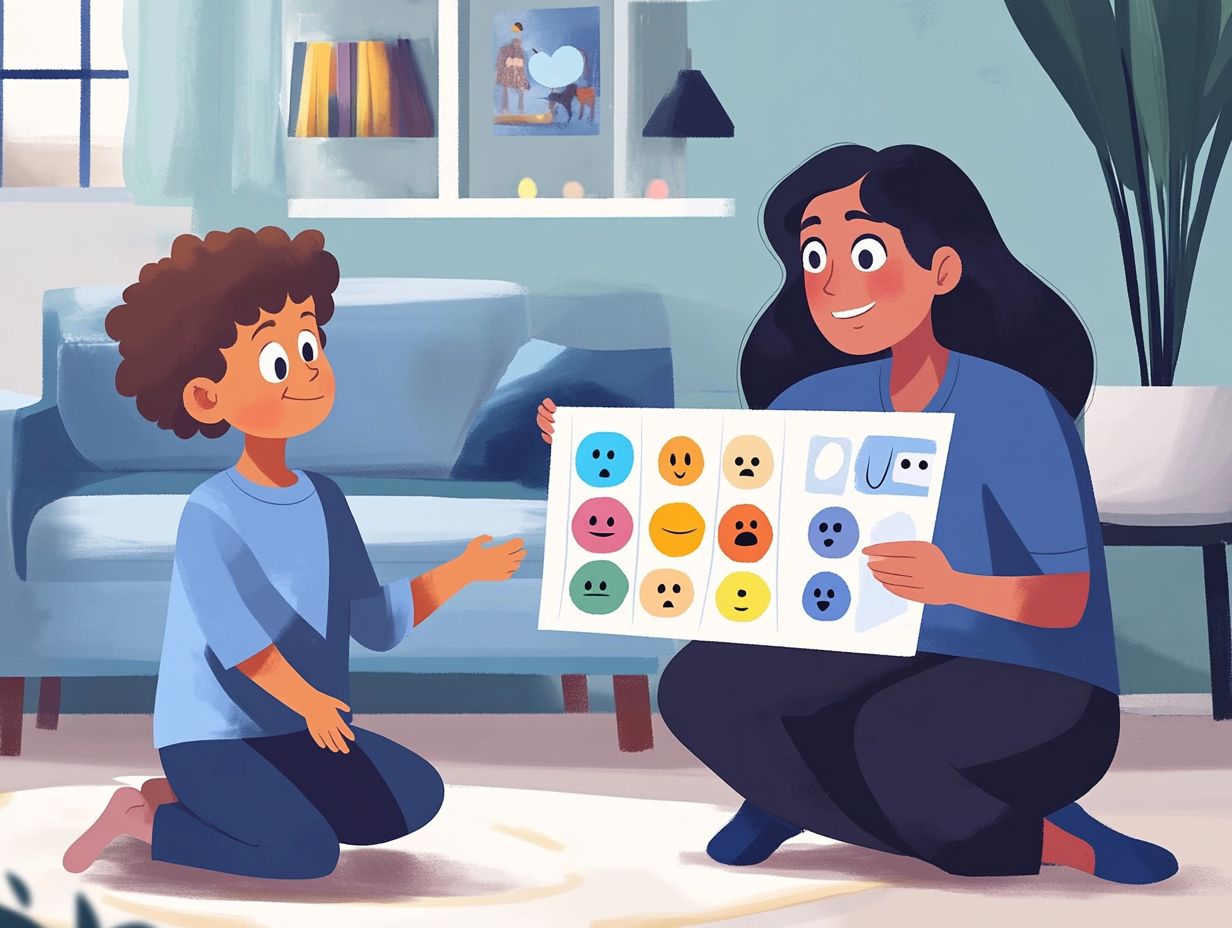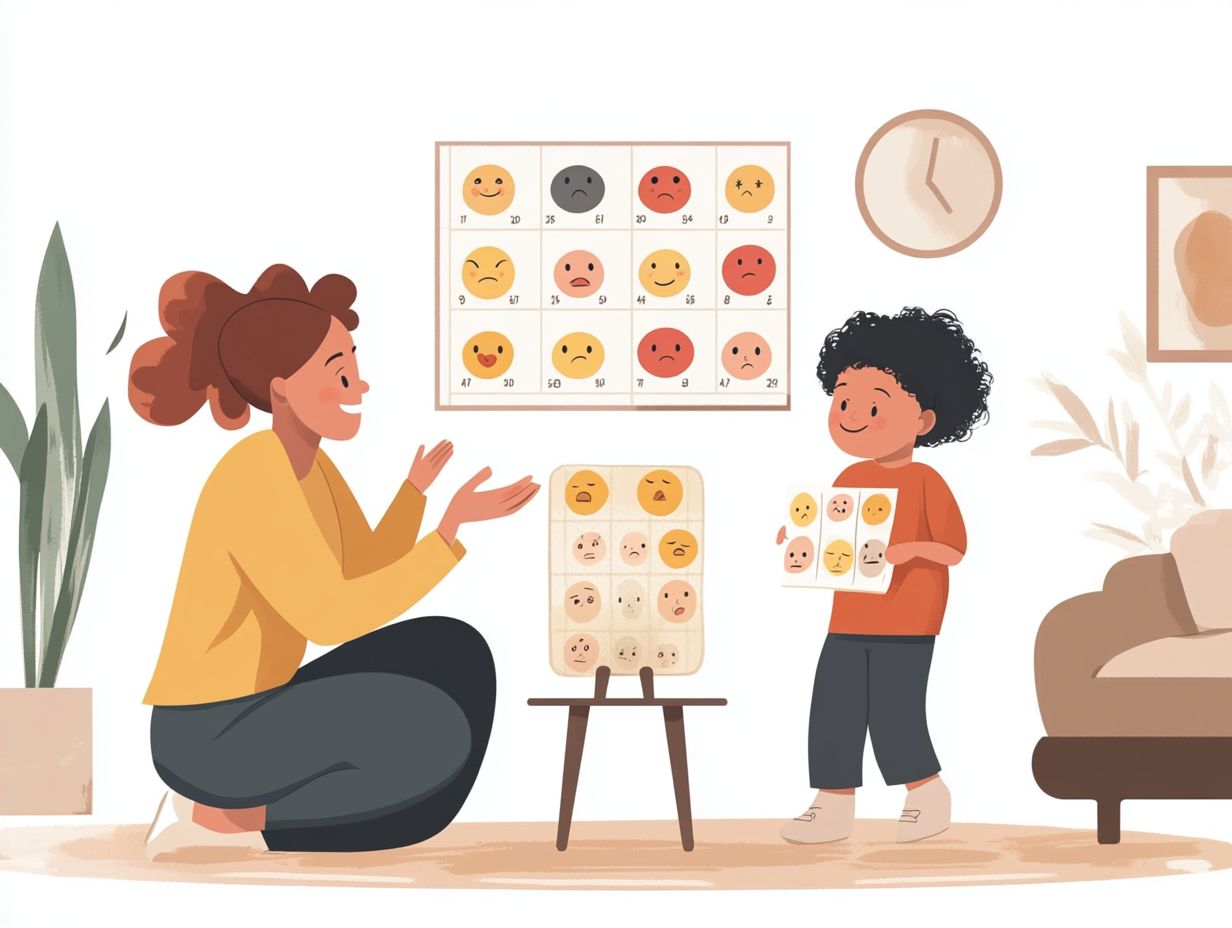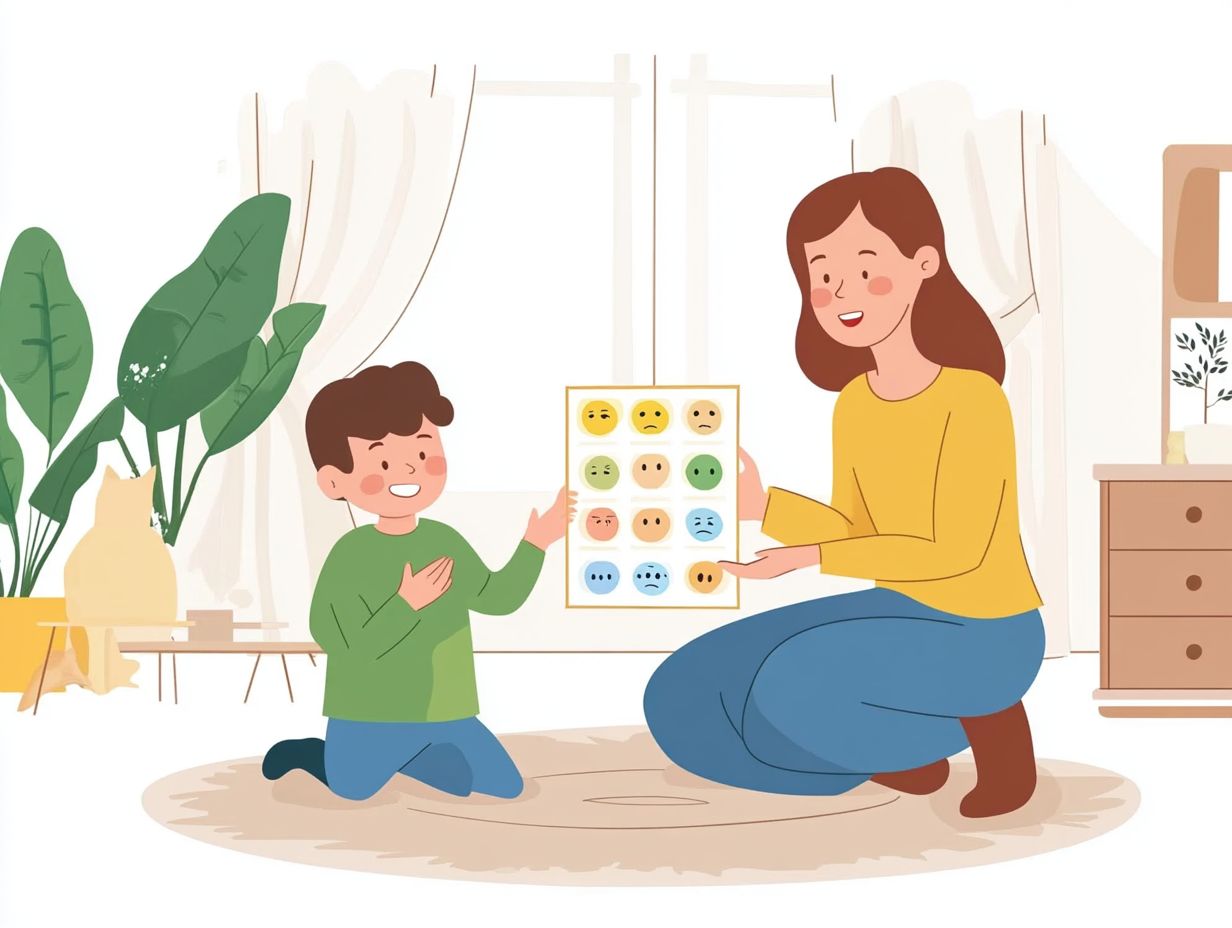How to Discuss Emotions with Your Child
Understanding and discussing emotions with your child is vital for their emotional well-being and development. This article delves into the significance of having open conversations about feelings, emphasizing the positive impact on mental health, emotional intelligence, and overall child development.
You ll discover practical tips for initiating these important discussions, along with strategies that encourage your child to express themselves fully. Additionally, you ll gain insights into navigating both the highs and lows of emotions, including negative feelings like sadness, fear, and jealousy. The article addresses common challenges parents encounter and offers valuable resources to support your child’s emotional growth and health.
Embrace the opportunity to foster a healthier emotional landscape for your family by creating an environment rich in emotional support and understanding!
Contents
- Key Takeaways:
- Why is it Important to Discuss Emotions with Your Child?
- How Can Discussing Emotions Improve Your Child’s Mental Health?
- How to Start the Conversation about Emotions with Your Child?
- What Are Some Tips for Talking to Your Child about Emotions?
- What Are Some Strategies for Encouraging Your Child to Open Up?
- What Types of Emotions Should You Discuss with Your Child?
- Understanding Emotions in Children
- How to Discuss Complex Emotions with Your Child?
- What Are Some Common Challenges When Discussing Emotions with Children?
- How to Support Your Child’s Emotional Development
- How to Support Your Child’s Emotional Development?
- Frequently Asked Questions
- How do I begin discussing emotions with my child?
- What are some ways to help my child identify their emotions?
- How can I teach my child healthy ways to express their emotions?
- What should I do if my child doesn’t want to talk about their feelings?
- How do I handle it if my child’s emotions seem overwhelming or intense?
- What are some ways to continue discussing emotions with my child as they grow older?
Key Takeaways:

- It is important to discuss emotions with your child to promote their mental health, emotional well-being, and overall family relationships.
- Start the conversation by actively listening, validating their feelings, encouraging them to express feelings, and creating a safe space for them to open up.
- Discuss both positive and negative emotions with your child and help them understand and manage complex emotional reactions.
Why is it Important to Discuss Emotions with Your Child?
Discussing emotions with your child is vital, as it establishes a strong foundation for their emotional intelligence and overall well-being. By engaging in meaningful conversations about feelings, you can guide your child in learning how to express and manage their emotions effectively, thereby enhancing their understanding of emotions and communication skills.
This open dialogue creates a supportive environment where emotional responses are understood and validated, promoting a healthy family atmosphere and ultimately strengthening family bonds. This practice also fosters empathy and emotional awareness key skills for successfully navigating social interactions and conflicts.
As a result, this practice promotes healthy conflict resolution skills and supports your child’s emotional development, equipping them to tackle future challenges with confidence.
What Are the Benefits of Talking About Emotions?
Discussing emotions brings a wealth of benefits for children, including a deeper emotional understanding and enhanced communication skills. By guiding them to recognize and express their feelings, you can nurture a robust emotional vocabulary that enables your child to articulate their experiences with clarity and confidence.
This insight fosters healthier emotional regulation, enabling them to navigate negative emotions like sadness, anger, jealousy, and resentment more effectively. Engaging in conversations about emotions cultivates empathy and emotional connections essential traits for forging meaningful relationships and skillfully navigating social situations.
As your child learns to express their feelings, you ll likely notice a reduction in their anxiety; they ll be able to verbalize their struggles rather than suppressing them. For example, a study involving preschoolers revealed that those encouraged to talk about their emotions were far better equipped to resolve conflicts with their peers.
This ability to regulate their emotions not only aids in managing their own feelings but also enhances their empathetic responses toward others, allowing them to recognize and support friends who may be feeling upset or anxious, thereby improving their social emotional development.
Ultimately, fostering open communication about emotions transforms your child s social interactions, leading to a richer sense of community and belonging.
How Can Discussing Emotions Improve Your Child’s Mental Health?
Talking about emotions is key to boosting your child’s mental health. It helps them develop coping strategies for tough feelings.
When children feel free to express themselves, they become more resilient against stress and sadness.
This ongoing dialogue strengthens their emotional regulation skills. These skills are vital for maintaining well-being and preventing behavioral issues.
Open conversations about feelings reduce the stigma around mental health. This allows children to seek help more comfortably.
Research shows that kids who regularly discuss their emotions are better equipped for life’s challenges. A study in the Journal of Child Psychology and Psychiatry found that children with strong emotional awareness are 30% less likely to develop anxiety or depression later on.
Experts highlight that teaching kids to recognize and express their feelings leads to better relationships and improved mental health.
By fostering an environment where feelings are openly discussed, you nurture confident individuals ready to face personal and social challenges with resilience.
How to Start the Conversation about Emotions with Your Child?
Starting a conversation about emotions can feel daunting. However, it s a crucial step in supporting their emotional growth.
Create a comfortable environment where feelings can be explored freely. Always validate feelings as they are expressed.
Use resources like feelings charts or stories that explore emotional themes. This will guide discussions and teach about emotions.
Approach the topic with care. Encourage your child to express their feelings without fear of judgment.
As you engage, validate their emotions and share your experiences. This shows that healthy emotional expression is natural and important.
Improving their emotional literacy will enhance their emotional health.
What Are Some Tips for Talking to Your Child about Emotions?
Using effective strategies can greatly enhance your child’s emotional literacy. Start with simple language and age-appropriate terms to build their emotional vocabulary.
Encourage your child to express their feelings, validating these emotions and reinforcing that all feelings are okay.
Use tools like feelings charts or role-playing to create valuable discussions. Engaging in active listening is also important; show empathy by reflecting on their feelings.
Introduce storytelling as a fun way to explore emotions. Reading books with characters facing various emotions can lead to meaningful conversations.
Creating a designated ‘feelings time’ during family routines makes discussing emotions a regular practice.
Don’t shy away from using art projects or journaling as creative ways for your child to express their feelings. Building a home rich in emotional support will encourage your child to feel safe sharing their thoughts.
What Are Some Strategies for Encouraging Your Child to Open Up?
Encouraging your child to open up about their emotions takes finesse. Thoughtful strategies can cultivate emotional connection and support.
Create a family atmosphere where feelings can flow freely. Establish regular moments for emotional check-ins perhaps during dinner or at bedtime. Regularly practicing this will enhance their ability to identify feelings and manage emotions effectively.
Ask open-ended questions that invite deeper discussions about their day and feelings. This also enhances their listening skills in the process. By modeling vulnerability and sharing your own emotional experiences, you help normalize emotional expression and build trust between you and your child. This is an essential aspect of role modeling in parenting!
Introducing mindfulness practices can significantly elevate emotional awareness. Encourage your child to participate in mindfulness exercises like deep breathing or guided imagery, which can help them articulate their feelings more clearly. Make sure to create a safe space for them to express their thoughts, actively listening and validating their emotions without any judgment. These practices also help with anger management and self-regulation skills.
Nurturing empathy in family interactions fosters an environment where emotional openness is not just accepted but celebrated. This positive dynamic supports your child’s overall problem-solving and behavior management abilities!
Together, these strategies enable your child to navigate their emotions with confidence and resilience, setting them up for amazing success in their emotional journeys. It also helps in mitigating potential behavioral issues and promotes healthy conflict resolution skills.
What Types of Emotions Should You Discuss with Your Child?

When engaging in conversations about emotions with your child, it s crucial to acknowledge and address the full spectrum of emotional experiences, encompassing both positive and negative feelings.
Positive emotions such as joy, love, and gratitude can significantly enhance emotional awareness and contribute to a sense of well-being. On the flip side, negative emotions like anger, sadness, fear, and jealousy are just as vital to discuss, as they often serve as gateways to emotional growth and understanding.
By creating a safe and welcoming environment for exploring these feelings, you enable your child to cultivate a rich emotional vocabulary and develop effective coping strategies.
Understanding Emotions in Children
How to Talk to Your Child About Positive Emotions?
When engaging in conversations about emotions with your child, it s crucial to acknowledge and address the full spectrum of emotional experiences, encompassing both positive and negative feelings.
Positive emotions such as joy, love, and gratitude can significantly enhance emotional awareness and contribute to a sense of well-being. On the flip side, negative emotions like anger, sadness, fear, and jealousy are just as vital to discuss, as they often serve as gateways to emotional growth and understanding.
By creating a safe and welcoming environment for exploring these feelings, you enable your child to cultivate a rich emotional vocabulary. You also help them develop effective coping strategies.
Consider leveraging materials such as the film Inside Out or the parenting program Tuning in to Kids, which are designed to help children and families discuss and manage emotions. Experts like Marc Brackett and Bren Brown also offer valuable insights into emotional intelligence and resilience.
Engaging in conversations with your child about positive emotions can be a transformative journey that nurtures their understanding of emotions. Start by sharing your own experiences of joy, love, and accomplishment. This creates a relatable framework for your child to connect with. Such conversations can significantly benefit their emotional well-being and help them manage emotions effectively.
By incorporating personal anecdotes and vivid storytelling, you can turn these discussions into captivating narratives that ignite your child s curiosity and motivate them to delve into their own emotions. This method can also enrich your child’s emotional vocabulary.
Pose open-ended questions that encourage your child to reflect on joyful moments from their day, whether it s a delightful playdate or a cozy family meal. This approach not only validates their positive feelings but also fosters a safe space for emotional exploration.
Ultimately, acknowledging and affirming these uplifting emotions is vital in nurturing your child’s emotional intelligence. This equips them with the skills to navigate life with enhanced empathy and resilience. This practice also serves as valuable emotional coaching, preparing them for future emotional experiences.
How to Address Negative Emotions with Your Child?
Addressing negative emotions with your child is essential for fostering their emotional regulation and coping strategies, especially when it comes to feelings like sadness and anger. When your child expresses these emotions, approach the situation with empathy and validate their feelings to ensure they feel heard and understood.
Show them that their experiences are entirely valid, and encourage open dialogue about emotions without any judgment. For instance, when your child is upset, you might say, “It’s okay to feel sad; let s talk about what made you feel this way.” Implementing techniques like empathetic listening which involves truly hearing and understanding your child’s feelings allows them to express themselves fully.
You can model healthy emotional responses by demonstrating how to cope with disappointment or frustration calmly.
Engaging in activities such as journaling or creative arts can also serve as valuable outlets for emotions. These activities help your child discover productive ways to express themselves rather than resorting to outbursts.
Start this journey today! Encourage your child to open up about their feelings and embrace the opportunity to understand their emotions better.
Addressing negative emotions with your child is essential for helping them manage their feelings and develop coping strategies. Feelings like sadness, fear, resentment, and anger can be challenging for children. When your child expresses these emotions, approach the situation with empathy and validate their feelings to ensure they feel heard and understood. This process aids in developing their emotional awareness and emotional health.
Show them that their experiences are completely valid. Encourage open dialogue about emotions without any judgment. For instance, when your child is upset, you might say, “It’s okay to feel sad; let s talk about what made you feel this way.” Using techniques like listening with empathy allows your child to express themselves fully. You can model healthy emotional responses by demonstrating how to cope with disappointment or frustration calmly. This practice is known as setting an example, which is a crucial aspect of child development.
Engaging in activities like journaling or creative arts can also serve as valuable outlets for emotions. These activities help your child discover productive ways to express themselves instead of resorting to outbursts.
How to Discuss Complex Emotions with Your Child?
Discussing complex emotions with your child can feel overwhelming, yet it s vital for enhancing their emotional understanding and awareness. Start by introducing the concept of mixed feelings. Use relatable examples from their own life or popular media, such as the movie *Inside Out*. Encourage them to explore situations where they experience both happiness and sadness or love and jealousy. This fun approach allows them to discover the exciting world of mixed emotions! It also fosters empathy towards themselves and others.
How to Discuss Complex Emotions with Your Child?
Discussing complex emotions with your child can be a daunting task, yet it s essential for enhancing their emotional understanding and awareness. Begin by introducing the concept of mixed feelings, drawing on relatable examples from their own life or popular media, such as the movie *Inside Out*. Encourage them to explore situations where they experience both happiness and sadness or love and jealousy. This approach not only helps them recognize the nuances of emotional experiences but also fosters empathy towards themselves and others. Scholars like Marc Brackett and Andrew Fuller have emphasized the importance of discussing complex emotions for children’s social and emotional growth.
As a parent, sharing your own experiences can be invaluable. Renowned experts like Bren Brown from the University of Houston have highlighted the importance of vulnerability and sharing personal experiences in parenting. Illustrate times when you grappled with conflicting emotions; this not only validates your child s feelings but also creates a safe space for open communication.
Try asking questions such as, “How would you feel if…” or “Have you ever felt torn between two choices?” Such dialogues enable your child to express themselves freely and develop a deeper understanding of their emotional landscape.
By recognizing and discussing these feelings, you reinforce the notion that experiencing a range of emotions is both normal and healthy an essential component of their emotional growth.
What Are Some Common Challenges When Discussing Emotions with Children?
Common Resistance
When discussing emotions with children, you may often face familiar challenges like resistance or avoidance, which can obstruct open communication and emotional understanding. Some children may also show behavioral issues that complicate these conversations.
Children might find it difficult to express their feelings or fear judgment for sharing negative emotions. In addition, some children may exhibit emotional reactions that complicate these conversations, making it tough for you to engage effectively.
Start by recognizing these challenges to build an emotionally supportive environment.
How to Overcome Resistance or Avoidance from Your Child?

Overcoming resistance or avoidance from your child requires carefully crafted strategies that promote emotional support and enhance listening skills. Start by creating a safe, non-judgmental environment where your child feels comfortable expressing their feelings.
Use open-ended questions to encourage dialogue, and be patient, allowing them to share at their own pace. Validate their feelings by acknowledging their fears or hesitations, and reinforce that it s perfectly okay to talk about emotions.
Establishing this foundation of trust is essential for effective communication and emotional connection. When children know they are truly heard and understood, they are much more likely to engage with you instead of retreating into silence.
Use specific questions that guide the conversation toward their thoughts and opinions, allowing them to feel genuinely involved in the discussion. Practicing active listening is crucial this means giving your full attention, maintaining eye contact, and holding back from interrupting while they share.
It s important to recognize that overcoming resistance takes time; respond with empathy to their struggles and celebrate those small victories along the way. Using resources like Tuning in to Kids and Circle Of Security Parenting can provide parenting help and strategies for building emotional support systems. This approach reinforces a continuous, trusting connection between you and your child.
How to Handle Difficult Emotions or Situations?
Handling difficult emotions or situations requires you to model emotional regulation and teach effective coping strategies to your child. When faced with challenging feelings like anger or fear, guide your child in identifying their emotions and exploring the triggers behind them.
This journey begins with encouraging them to articulate their feelings, perhaps using visual aids like emotion charts or storytelling exercises. For example, if your child feels overwhelmed during a school presentation, discussing the situation openly and framing it as a learning experience can be invaluable.
This can also aid in anger management and addressing emotional triggers effectively. By collaborating on potential solutions, you help foster their problem-solving skills perhaps practicing their speech together in a safe environment.
Encouraging emotional awareness through daily reflections can promote healthy dialogue about feelings, making it easier for your child to navigate complex emotions in the future. Experts like Francyne Zeltser, Jaclyn Shlisky, and Dimitri Otis have emphasized the benefits of such practices for children’s emotional health.
How to Keep the Conversation Open and Ongoing?
Keeping the conversation about emotions open and ongoing is essential for nurturing emotional awareness and fostering a deep connection between you and your children.
To create an environment where emotional dialogue flourishes, it s beneficial for you to initiate these discussions regularly. Consider establishing a tradition of sharing feelings during family meals or in a relaxed setting while enjoying recreational activities together; this approach allows for a natural flow of conversation.
By encouraging your children to express both their emotional highs and lows, you validate their experiences and help them feel understood. This practice also fosters a healthy family environment where emotional expression is normalized.
Introducing tools like feelings charts can significantly enhance these discussions, making it easier for your children to identify and articulate their emotions. Continually reinforcing that these exchanges are a safe space for expression will help cultivate a deep and lasting emotional bond.
Remember, consistently validating feelings during these interactions strengthens trust and openness in your parent-child relationship.
How do you currently talk to your child about their feelings? Reflect on your methods and consider new approaches.
How to Support Your Child’s Emotional Development
How to Support Your Child’s Emotional Development?
Supporting your child’s emotional development requires a proactive approach to help them understand their feelings better. Engage them in activities that foster emotional expression, such as art, storytelling, or role-playing.
Equip them with coping strategies that enable them to navigate their emotions effectively. This will help them manage stress and enhance their overall emotional well-being. Cultivate a supportive environment where open conversations about feelings are encouraged, allowing your child to feel safe expressing their thoughts and experiences.
Incorporating resources from Partners in Parenting and ChildLine can provide essential guidance and support systems for both parents and children.
What Are Some Activities or Techniques for Teaching Emotional Intelligence?
Incorporating activities and techniques for teaching emotional intelligence can truly elevate your child’s emotional literacy and self-control skills. Engaging in fun activities like role-playing, storytelling, and using feelings charts encourages children to identify and express their emotions effectively. These methods are supported by experts in child psychology and social emotional development.
Mindfulness practices, such as deep breathing or guided imagery, can further aid them in developing emotional awareness and coping with difficult feelings. These practices are often recommended by the Mental Health Foundation for enhancing emotional health. These techniques not only nurture a deeper understanding of emotions but also cultivate resilience and enhance problem-solving abilities.
Creating a safe space for open discussions about emotions is essential. This allows your child to share their feelings without fear of judgment. Engaging in cooperative games teaches teamwork and empathy, while art activities like drawing or painting emotions provide a wonderful outlet for creative expression. Utilizing a feelings chart is a fun way to help kids learn to identify and communicate their emotions effectively.
Taking advantage of resources like children’s books focused on emotional experiences can spark meaningful conversations that deepen understanding. Experts recommend regularly integrating these activities to foster long-term emotional growth, equipping your child with essential tools to navigate social challenges and manage emotions as they mature.
How to Create a Safe and Supportive Environment for Your Child to Express Their Emotions?
Creating a safe and supportive environment for your child to express their emotions is essential for fostering their emotional well-being and promoting healthy communication. Start by establishing clear ground rules that encourage respect and openness during discussions about feelings and emotional reactions.
These rules might include no interrupting while someone speaks and using kind words to convey thoughts and concerns. It s also vital to practice active listening, which means genuinely engaging with your child nodding and responding appropriately to demonstrate that their thoughts truly matter. This approach helps build strong communication skills and emotional vocabulary.
Validating their emotions is imperative; acknowledging their feelings without judgment reinforces their right to experience whatever they are feeling. Such strategies strengthen the emotional connection within the family environment and equip children with the tools they need to articulate themselves effectively.
Over time, this nurturing approach fosters an atmosphere of trust and understanding, enabling your children to feel secure in sharing their thoughts and emotions, including negative emotions like sadness, fear, and jealousy.
Start implementing these strategies today for your child s emotional growth!
What Are Some Resources for Parents to Learn More About Discussing Emotions with Children?
You ll find a wealth of resources at your fingertips to help you discuss emotions with your children think books, workshops, and online platforms dedicated to emotional literacy and coaching.
In today s fast-paced world, grasping the nuances of emotional intelligence understanding and managing feelings is more essential than ever for engaging in meaningful conversations with your kids.
Resources like ChildLine and the NSPCC offer extensive parenting help and emotional support.
By drawing upon priceless insights from esteemed experts like Bren Brown from the University of Houston, who highlights the power of vulnerability and connection, along with Marc Brackett, who emphasizes the importance of recognizing feelings, you can significantly expand your emotional vocabulary.
Programs like Tuning in to Kids, designed to help you notice and respond to your child’s emotions, and Circle of Security Parenting, which focuses on fostering secure attachments, offer structured approaches to nurture emotional development and emotional regulation.
Many websites and online forums provide strong support networks, offering guidance and resources that enable you to navigate complex emotional discussions with confidence.
Mindfulness practices and empathy exercises can also play a crucial role in enhancing your child’s emotional understanding and self-regulation.
Frequently Asked Questions

How do I begin discussing emotions with my child?
Start by creating a safe and open environment for your child to express their feelings. Let them know that all emotions are valid and that you are there to support and listen to them.
What are some ways to help my child identify their emotions?
Encourage your child to use “feeling words” to describe how they are feeling. You can also use scenarios from books or movies like “Inside Out” to ask how the characters might be feeling and relate it to your child’s own experiences.
Additionally, a feelings chart can be a helpful tool for kids to identify feelings.
How can I teach my child healthy ways to express their emotions?
Show your child how to express emotions in a healthy way and encourage them to do the same. You can also teach them coping strategies such as deep breathing or journaling to help manage their emotions and practice anger management.
Role modeling effective emotional communication is essential for child development.
What should I do if my child doesn’t want to talk about their feelings?
Respect their boundaries and let them know that you are there for them whenever they are ready to talk. You can also try engaging in a relaxing activity together, such as drawing or listening to music, to create a comfortable atmosphere for discussion.
Collaborate with support systems like Partners in Parenting or a professional therapist for additional guidance.
How do I handle it if my child’s emotions seem overwhelming or intense?
Remain calm and avoid dismissing or invalidating their emotions. Validate feelings by letting them know that it’s okay to feel strong emotions like resentment and offer support and comfort.
If necessary, seek guidance from a professional therapist who specializes in child psychology and emotional coaching.
What are some ways to continue discussing emotions with my child as they grow older?
As your child gets older, continue to have open and honest conversations about emotions. Encourage them to share their feelings and validate their experiences.
You can also introduce more complex emotions and discuss how to manage them in a healthy way. Behavioral issues may arise, and teaching problem-solving and healthy conflict resolution will be crucial.
Start today by using these resources to enhance your conversations about emotions with your children!






